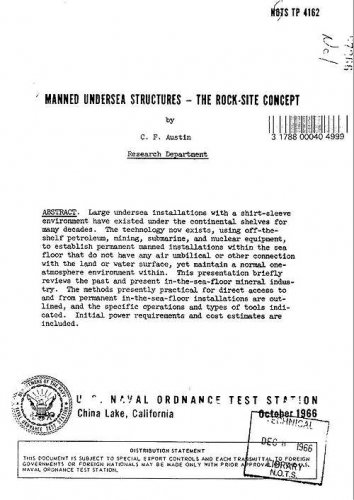- Joined
- 13 August 2007
- Messages
- 7,813
- Reaction score
- 8,822
found this on conspiracy site so take the info with cautious
The Rock-Site Concept, by C.F. Austin. NOTS TP 4162. U.S. Naval Ordnance Test Station, China Lake, California, October 1966
if this is a real proposal
Got someone more info about this program ?
The United States Navy's "Rock-Site" concept calls for placing large, permanently manned installations deep beneath the bed of the ocean.
Such facilities could be tens or even hundreds of miles out to sea. Tunnels could be driven beneath the sea floor, extending hundreds of miles up and down the Atlantic, Pacific and/or Gulf of Mexico Coasts.
The tunnels could originate on land and extend out under the ocean for many, many miles.
Alternatively, a manned undersea base could be constructed beneath the sea floor with no connection with land whatsoever. The technology to do this has existed for decades.
The world's oceans and seas contain many potential "Rock-Site" locations. These sea mounts off the coasts of Iberia and Africa are strategically located near the busy sea lanes of the North Atlantic and the vital Strait of Gibraltar at the entrance to the Mediterranean Sea. United States Navy, circa 1960s.
The Rock-Site Concept, by C.F. Austin. NOTS TP 4162. U.S. Naval Ordnance Test Station, China Lake, California, October 1966
if this is a real proposal
Got someone more info about this program ?


